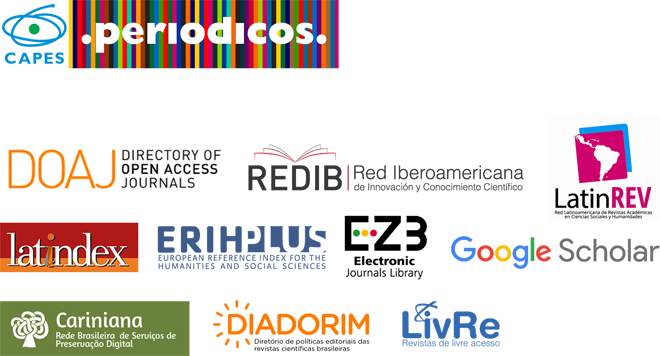Arte Contemporânea e Novas Mídias: Partilha Digital ou Discurso Híbrido?
DOI:
https://doi.org/10.36025/arj.v2i2.7295Palavras-chave:
Arte digital, híbrido, arte contemporânea, mundo da arte, valor de mercadoResumo
A arte digital e suas características híbridas embasam debates no desenvolvimento econômico e cultural, internacionalmente, e este artigo tem como objetivo discutir tal contexto enquanto uma pesquisa transdisciplinar colaborativa nas intersecções entre arte, ciência e tecnologia. Novos meios de comunicação expandem as possibilidades na arte, reveem suas aplicações estéticas e implicações sociais no campo da ciência e da tecnologia. A relação entre arte eletrônica e a produção mainstream ocupa artistas, curadores e teóricos há muitas décadas, assim como coloca suas práticas dentro dos contextos teóricos e de exposição do mercado de arte contemporânea, para além do desenvolvimento de sua própria linguagem teórica e dos contextos institucionais. Este texto trata do modo como se entende a relação entre o mundo da arte contemporânea, o qual na década de 2000 e 2010 consolidou mais do que nunca uma concorrência acirrada, e a arte digital, a qual alcançou um nível de autonomia e autogestão sem precedentes. Este relacionamento traz discussões sobre o valor de mercado, a autoria, o pluralismo e os atritos internos.
Tradução de Giovanna Casimiro.
Downloads
Referências
BECKER, Howard. Art Worlds. Berkeley: University of California Press, 1982.
BIJVOET, Marga. Art as Inquiry: Toward New Collaborations Between Art, Science, and Technology. Bern: Peter Lang, 1997.
BISHOP, Claire, 2012a. Artificial Hells: Participatory Art and the Politics of Spectatorship. London and Brooklyn: Verso, 2012.
BISHOP, Claire, 2012b. Rejoinder to Cornell and Droitcour. Artforum, 2012 (Jan): 38.
BISHOP, Claire, 2012c. Digital Divide: Contemporary Art and New Media Artforum, 2012 (Sept): 434-41.
BOURRIAUD, Nicolas. Relational Aesthetics. Trans. Simon Pleasance & Fronza Woods with Mathieu Copeland. Paris: Les presses du reel, 2002, c. 1998 (French).
BUCHLOH, Benjamin. Hans Haacke: Memory and Instrumental Reason Art in America, 1988, 76:2 (February); 97-108, 157-59.
BURNHAM, Jack. Steps in the Formulation of Real-Time Political Art in Kaspar Koenig, ed., Hans Haacke: Framing and Being Framed, 7 Works 1970-75. Halifax: The Press of the Nova Scotia College of Art and Design, 1975.
CORNELL, Lauren and Brian Droitcour, 2013. Technical Difficulties (Reply to Claire Bishop, Digital Divide). Artforum (Jan): 36,38.
DANTO, Arthur. The Artworld, The Journal of Philosophy, Vol. 61, No. 19, American Philosophical Association Eastern Division Sixty-First Annual Meeting. (Oct. 15, 1964): 571-584.
FULLER, Matthew. Software Studies: A Lexicon. Cambridge, MA: MIT Press, Ed. 2008.
GRAHAM, Beryl and Sarah Cook. Rethinking Curating: Art after New Media. Cambridge, MA: MIT Press, 2010.
HAYLES, N. Katherine. Print is Flat, Code Is Deep: The Importance of Media-Specific Analysis. Poetics Today 25:1 (Spring): 67-90, 2004.
HEARTNEY, Eleanor, 2012. The Incredible Shrinking Art Critic Brooklyn Rail (Dec 10, 2012). http://www.brooklynrail.org/2012/12/artseen/the-incredible-shrinking-art-critic’’ Cited 28 Oct 2012.
HOROWITZ, Noah. Art of the Deal: Contemporary Art in a Global Financial Market. Princeton University Press, 2011.
JONES, Caroline. Systems Symptoms: Jack Burnham’s ‘Systems Esthetics. Artforum, 2012 51: 1 (September): 113-114, 116.
JOSELIT, David. Art After. Princeton: Princeton University Press, 2012.
KAY, Alan and Adele Goldberg. Personal Dynamic Media Computer 10:3. 1977 (March): 31-41.
KEEN, Andrew. The Cult of the Amateur: How Today’s Internet Is Killing Our Culture. New York: Crown Business Publishing, 2007.
KESTER, Grant. Conversation Pieces: Community and Communication in Modern Art. Berkeley: University of California Press, 2004.
KESTER, Grant. The One and the Many: Contemporary Collaboration in a Global Context. Durham: Duke University Press, 2012.
KIM, Ji-Hoon. The Postmedium Condition and the Explosion of Cinema, Screen , 2009, 50:1: 114-23.
Kosuth, Joseph. Art after Philosophy I, II, III Studio International, CLXXVIII , 1969 (Oct, Nov, Dec): 134-37; 160-61: 212-13.
KRAUSS, Rosalind. The Guarantee of the Medium, Tiina Arppe, Timo Kaitaro and Kai Mikkonen, eds. Studies across Disciplines in the Humanities and Social Sciences 5. Helsinki: Helsinki Collegium for Advanced Studies, 2009, 139-145.
MANOVICH, Lev. Software Takes Command. New York: Bloomsbury Academic, 2013.
MURRAY, Soraya. New Media Anxiety: Art History and the Problem of Modern Technology. Doctoral dissertation, Cornell University, 2007.
Paul, Christiane. New Media in the White Cube and Beyond: Curatorial Models for Digital Art. Berkeley: University of California Press, 2008.
QUARANTA, Domenico. The Postmedia Perspective, Rhizome, 2011 (Jan 12).
RAO, MALLIKA. Controversial New Project Uses Algorithm to Predict Art Huffington Post, 2013 (Nov 5).
SHANKEN, Edward A. Art in the Information Age: Technology and Conceptual Art, in SIGGRAPH 2001 Electronic Art and Animation Catalog, (New York: ACM SIGGRAPH): 8-15; expanded in Leonardo 35:4 (August, 2002): 433-38.
SHANKEN, Edward A. Historicizing Art and Technology: Forging a Method, Firing a Canon, in Oliver Grau, ed., Media Art Histories. Cambridge: MIT Press, 2007. p 43-70.
SHANKEN, Edward A. Reprogramming Systems Aesthetics: A Strategic Historiography. Simon Penny, et al, eds., Proceedings of the Digital Arts and Culture Conference 2009. Berkeley: University of California Press, 2009.
SHIRKEY, Clay. Here Comes Everybody: The Power of Organizing Without Organizations. New York: Penguin, 2008.
SKREBOWSKI, Luke. All Systems Go: Recovering Hans Haacke’s Systems Art Grey Room 30, 2008 (Winter) 54-83.
TAGG, John. The Burden of Representation: Essays on Photographies and Histories. Minneapolis: University of Minnesota Press, 1993.
THORNTON, Sarah. Seven Days in the Art World. London: Granta, 2008.
TROEMEL, Brad. The Accidental Audience The New Inquiry, 2013 (March 14).
VIERKANT, Artie. The Image Object Post-Internet . 2010http://jstchillin.org/artie/vierkant.html Cited Dec 4, 2013.
WEST, Nina P. The $900,000 Librarian, Forbes.com, 2008 (Oct 1). Cited 4 Nov 2013.
YOUNGBLOOD, Gene. Expanded Cinema. New York: P. Dutton Co., Inc, 1970.
Downloads
Publicado
Como Citar
Edição
Seção
Licença
Copyright (c) 2015 Edward Shanken (Autor)

Este trabalho está licenciado sob uma licença Creative Commons Attribution-NonCommercial-ShareAlike 4.0 International License.

Esta obra está licenciada com uma Licença Creative Commons Atribuição-NãoComercial-CompartilhaIgual 4.0 Internacional.
Autores detêm os direitos autorais ao licenciar sua produção sob Creative Commons Atribuição-NãoComercial-CompartilhaIgual 4.0 Internacional.


 English
English Português (Brasil)
Português (Brasil)
